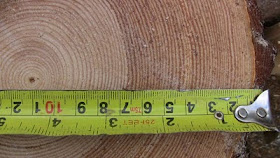Tree trail signs
I have been commissioned to make signs for a tree trail, so I thought I would make them stand out a bit by not just nailing a plank onto a stick. No metal has been used to hold these signs together, they rely on a dovetail joint.
The wood came from the forest the signs are going into, larch for the posts and Douglas fir for the arrow. I would have liked to have split the wood out of the logs, but in my experience softwood grown in this part of the world does not cleave. A chainsaw was used to rip the logs into quarters.
A dovetail notch was cut an inch or so deep into the post. This was done with an electric chainsaw, with the waste in the middle chiselled out.
The arrow part is just over two inches thick and the joint is chain sawed out, and tidied up with my GB carving axe and a flat chisel. The edges are tidied up with an axe. I did put the face of the arrow onto my jointer (planer) to flatten and smooth it. This is because of the Trend letter template I use to route the letters into the wood.
Fitting the two parts together does not take very long at all, just a bit of shaving with an axe and chisel, and a couple of trial fits. A small hole was bored through the post and arrow from the back and an oak dowel driven through so the sign cannot be taken off.
I wonder how many people will notice how they are made.
This idea came from the European dovetail joint, which I first saw on the Bodgers forum. This is a fantastic joint, which I will be using far more often. Its joy comes from it being self tightening and also it is quick and simple to knock apart, unlike a round mortice and tenon, which can lock tight.
Above is a photo of my bowl lathe made with the tapered dovetail joint, and below is the leg taken out. All that is needed to make this joint is a chisel and axe, although a saw will speed things up.
I have used an inch-and-something diameter augers to bore holes into my chopping blocks, benches etc.,but sometimes when I need to take them apart for storage or transport, the tenon leg gets stuck in the hole, especially at the end of a show when packing up the van. The round mortice and tenon is great for fixed joints, but not so clever for joints that need quick dismantling.









